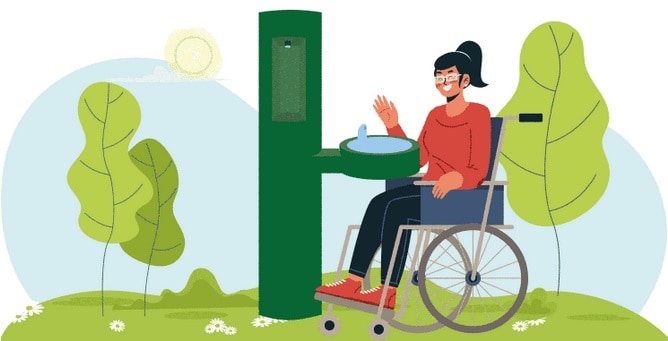Tap water sprinklers have established themselves on the Polish market for good. They are appearing in places such as parks, playgrounds, outdoor gyms, boulevards and town squares. The European Commission is preparing changes to the law that will not only determine the quality of the water flowing in our taps, but also guarantee access to drinking water for everyone - adults, children, the elderly and people with disabilities. We offer a number of solutions that meet these requirements, but we encourage you to first familiarise yourself with the guidelines that springs, sprinklers and tap water dispensers should meet so that everyone who wants to drink clean water can use them.
Designing water spigots to meet the needs of people with disabilities
Tap water sprinklers have established themselves on the Polish market for good. They are appearing in places such as parks, playgrounds, outdoor gyms, boulevards or town and city squares. In addition, the regulations on public access to drinking water are set to change in 2018. The regulations, which the European Commission is proposing to update, aim to improve the quality and safety of water but, above all, guarantee its free access in public spaces. This is why it is so important that the newly built installations provide access for all users, including those with disabilities.
Regulations in Poland and worldwide
In Poland, the disability law only regulates sanitary installations, i.e. toilets or washbasins; unfortunately, tap water was never included in these regulations.
In the USA, this problem is regulated by the ADA (Americans with Disabilities Act (translation: Americans with Disabilities Act). In the absence of legislation in Poland, they provide a kind of guideline for the rules we should follow when making investments in the installation of springs or drinking water springs. These regulations clearly define the height of the installation of the bowls, the free manoeuvring space for wheelchairs or other issues relating to different groups of disabled people.
When designing a public space, we should remember that the tap water dispenser we would like to install should have an additional side bowl to allow easy wheelchair access, and the height of the bowl should be located at the heights shown in the diagram below.


The knee space between the ground line and the bottom edge of the bowl should be 685 mm. The height of the spout from which you drink should be positioned no higher than 915 mm. It should be remembered that the water flow in water spouts is directed upwards, so a bowl mounted too high will not allow a person in a wheelchair to quench their thirst. The direction of the water flow and the position of the spout on the bowl is also very important. A spout with water flowing downwards or mounted on the opposite side of the bowl forces an unnatural body posture that is almost impossible for a person in a wheelchair to reach and often results in the person sitting in the wheelchair not being able to reach the spout with their mouth.
Examples of bad installations - spout installed in the wrong place:


Examples of poor installations - inappropriate design and height of sprinkler:


In addition, the space around the sprinkler should be free of barriers such as level differences, walls of any kind or stairs. The spa should be installed on a level and paved surface that allows a wheelchair to drive up without problems.


An important point to bear in mind is that the handicap side bowl should be 430 -485 mm from the wall or body of the unit. This will allow an adult in a wheelchair to drive up freely.
Examples of correct installations:



However, public space is not only about wheelchairs. A second group of disabled people are those with limb dysfunctions and paralysis who move around on crutches. These types of people need an additional support or handrail against which they can lean while drinking.


A final group to look out for when installing tap water dispensers are blind, visually impaired and elderly people. For these people, the actuating button should be painted in a colour that contrasts with the colour of the entire housing, and for blind people, a plaque in Braille stating what the device is and what it is used for is standard. This plaque is usually placed adjacent to the bowl or actuating button.


Examples of the installation of sprinklers providing access for people with disabilities:














